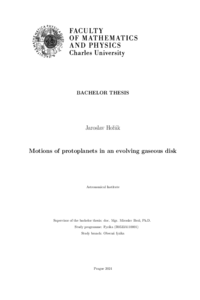Pohyby protoplanet ve vyvíjejícím se plynném disku
Motions of protoplanets in an evolving gaseous disk
bakalářská práce (OBHÁJENO)

Zobrazit/
Trvalý odkaz
http://hdl.handle.net/20.500.11956/193808Identifikátory
SIS: 256460
Kolekce
- Kvalifikační práce [11326]
Autor
Vedoucí práce
Oponent práce
Vokrouhlický, David
Fakulta / součást
Matematicko-fyzikální fakulta
Obor
Fyzika
Katedra / ústav / klinika
Astronomický ústav UK
Datum obhajoby
11. 9. 2024
Nakladatel
Univerzita Karlova, Matematicko-fyzikální fakultaJazyk
Čeština
Známka
Výborně
Klíčová slova (česky)
protoplanetární disk|sluneční soustavaKlíčová slova (anglicky)
protoplanetary disk|Solar SystemTitle: Motions of protoplanets in an evolving gaseous disk Author: Jaroslav Hořák Institute: Astronomical Institute Supervisor: doc. Mgr. Miroslav Brož, Ph.D., Astronomical Institute Abstract: Planets form from protoplanets orbiting young stars, when gaseous disk still exists. This gas gravitationally interacts with protoplanets, alongside mutual perturbations between protoplanets. This phenomenon is known as planetary migration. Our aim is to investigate the role of planetary migration, specifically, in the context of the terrestrial planets (Mercury, Venus, Earth, Mars). This has been studied previously with a stationary prescription for migration and without simulating the evolution of the disk (Brož et al. 2021). Instead, in this work we use formulae for migration torque based on actual profiles of the evolving disk. We used an N-body symplectic integrator to describe motions of protoplanets (Duncan et al. 1998). Evolution of the gas disk was modeled by 1-D hydrodynamics, considering turbulent viscosity and magnetically-driven disk wind (Suzuki et al. 2016). Migration torques were computed according to Paardekooper et al. (2011), from actual profiles of the disk. Moreover, our model included close encounters, collisions of protoplanets (merging), mutual resonances, eccentricity and inclination...
Title: Motions of protoplanets in an evolving gaseous disk Author: Jaroslav Hořák Institute: Astronomical Institute Supervisor: doc. Mgr. Miroslav Brož, Ph.D., Astronomical Institute Abstract: Planets form from protoplanets orbiting young stars, when gaseous disk still exists. This gas gravitationally interacts with protoplanets, alongside mutual perturbations between protoplanets. This phenomenon is known as planetary migration. Our aim is to investigate the role of planetary migration, specifically, in the context of the terrestrial planets (Mercury, Venus, Earth, Mars). This has been studied previously with a stationary prescription for migration and without simulating the evolution of the disk (Brož et al. 2021). Instead, in this work we use formulae for migration torque based on actual profiles of the evolving disk. We used an N-body symplectic integrator to describe motions of protoplanets (Duncan et al. 1998). Evolution of the gas disk was modeled by 1-D hydrodynamics, considering turbulent viscosity and magnetically-driven disk wind (Suzuki et al. 2016). Migration torques were computed according to Paardekooper et al. (2011), from actual profiles of the disk. Moreover, our model included close encounters, collisions of protoplanets (merging), mutual resonances, eccentricity and inclination...
